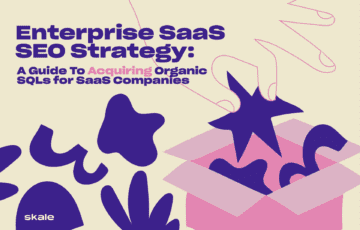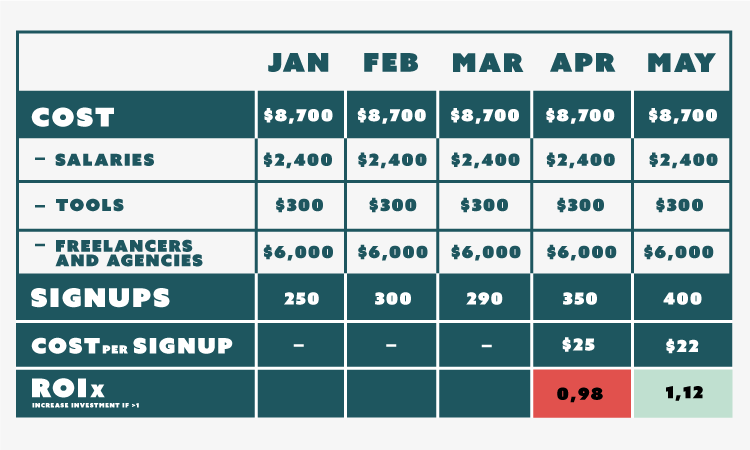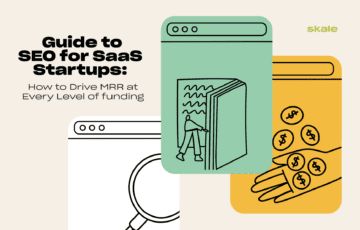
Enterprise SaaS SEO Strategy: A Guide to Acquiring Organic SQLs for SaaS Companies
Unlock the power of Enterprise SaaS SEO with tried-and-tested strategies from the experts & explore SEO tactics for SaaS enterprises.
![SaaS SEO ROI: How to Measure the Success of Your SEO Investment [+ Free Tracker]](https://skale.so/wp-content/uploads/2021/01/Skale-May-a.png)
To effectively scale your SEO channel, you need to be able to measure its ROI, every 👏 single 👏 month. 👏
In this SEO ROI guide we dive into:
We focus on cost per product signup. If your business model uses leads, then substitute signups with leads. If your business has a hybrid model, then use a combination of the two: measure cost per conversion (lead+signup).
Search engine optimization return on investment (SEO ROI) is a measure of how much business revenue the channel generates relative to the amount you’re investing into it each month. s This is important to measure as it’s a key indicator of whether your SEO strategy is a worthy investment, and can highlight opportunities for improvement.
When your marketing team understands SEO ROI, you’re able to benchmark its business impact against other channels or go-to-market strategies, and build internal business cases to win more SEO resources for the cause.
SEO is a long-term investment that compounds over time. You need to have patience, but the rewards are typically well worth the investment.
It’s a common misconception that SEO simply involves grabbing a load of keywords, flinging them at ChatGPT, and expecting readers to scream: take my money! It’s so much more than that.
An SEO investment involves content, sure, but the channel can be broken down into on-page and off-page efforts, technical efforts, and more. All of which need to be guided by a holistic SEO strategy and well thought-out growth marketing analyses. You can’t start posting in week one and expect results in week two. It takes time to align your SEO ducks, and a little longer for SEO tools to start showcasing results. Typically, you can expect to start seeing early signs of movement within a few weeks. But to see real business impact, it typically takes a few months, but this massively depends on the state that your site authority, current content, and technical SEO foundations are in when you start with SEO.
If you are yet to invest in SEO or have been investing in it for less than six months, then you cannot measure the ROI of your SEO channel.
You have decided to make a bet to scale a new customer acquisition channel and need to validate this bet after a 6-month period.
Why six months?
Because SEO takes time in the beginning to grow, for multiple reasons. To be successful, you need to:
The danger when validating this bet, is that you don’t put enough resources into it, and after six months you cannot make a decision to scale or kill this channel. This is the worst thing that can possibly happen when growing your SaaS company with SEO.
Here are some tips to make sure you are able to validate your SEO channel effectively within six months:
If you invest an average amount of resources, you’re going to get average results.

Ready for a 2500% increase in organic signups?
So was Happyscribe- that’s why they chose Skale’s ROI-driven link building service
Read the case studyIf you’ve been working on your SEO channel for at least six months, you’re now able to start measuring your channel’s ROI to understand how you can calibrate your monthly SEO budget.
From our experience working with a range of SaaS brands, it takes three months on average to see SEO impact after publishing new content, acquiring links, etc. You should consider a 3-month lag when measuring ROI.
Now we have aligned on the average lag to see SEO results, we now need to use two different calculations of ROI depending on if the SEO we are measuring is brand SEO or performance SEO.
Important: in your marketing budget you should already be differentiating between these two types of marketing (brand vs. performance). Sometimes performance is also called demand gen or growth. As a rule of thumb, on average companies invest 25% of their budget in brand and therefore 75% in performance marketing tactics.

Effectively measure your SEO ROI today
Take hold of your SaaS marketing ROI with our free tracker
Download for freePerformance SEO in the context of SaaS is all about driving leads and product signups, so you’re creating marketing content with the purpose to convert. Here you’re tackling product, solution and problem aware audiences.
Here are the five steps you need to take in order to effectively calculate ROI:
First you need to understand how much you can pay maximum in order to acquire a customer.
In SaaS we are looking at maintaining a 3:1 LTV:CAC ratio, within a max 12-month payback period (including the usual SEO lag).
Why? Because we want to scale a healthy SaaS company:
This means that you pay 1/3 of your lifetime value to acquire a single customer where your CAC / ARPA is less than or equal to 9.
If you don’t know the LTV of your SEO channel, then use your company-level LTV.
If your company doesn’t know its LTV, then you’ll need to align on a max cost per signup that I cover in the next section.
If you do have your LTV then you need to simply divide this by 3, and ensure that when dividing this final number by your ARPA, it doesn’t exceed 9.
Worked example:
Having a 9-month payback period ensures that you are able to recuperate your SEO investment within 12 months including the 3-month SEO lag.
Second, you now need to work back from your max CAC to understand how much you can pay to acquire an SEO signup. You’ll need to understand how a cohort of signups from +12 months ago converted into MRR to be able to establish the average 12-month conversion rate.
A) If you don’t know your max CAC or don’t have conversion rate data for the past 12 months
You have two options:
B) If you do know your max CAC and have conversion rate data from the past 12 months
Take a cohort of product signup from > 12 months ago and measure how it converted into MRR over a 12 month period. Calculate your 12-month signup conversion rate and divide your max CAC by this %.
Worked example:
Now we know how much we can spend to acquire an SEO signup, then we need to start tracking all of our SEO related costs every month so that our ROI is fully loaded.
Costs to include:
If you have a full-time employee working part-time on this channel, then include the % of their salary. E.g. you have a developer who works on average 10 hours / week, then take 25% of their total salary into consideration.
Now we have all the data, this last step is to build our ROI tracking spreadsheet.

Click here to download our ready-made SaaS SEO ROI tracker.
Here’s an overview of how this monthly tracker works:
Monitor your ROI every month to evaluate if you should increase or decrease your SEO investments. SEO is getting forever more competitive, so you should be investing as much so to maintain a 1x ROI month-on-month.
Thus, there shouldn’t be any cause for celebration if you have an ROI higher than1, because it means you are missing out on additional SEO opportunities, for example by not building out more content or links. You are already hitting your payback and LTV:CAC ratio goals to scale a healthy SaaS business so don’t stop your SEO investments increasing.
It’s a “CAC game”, at the end of the day.
Tracking your SEO campaigns’ ROI shouldn’t stop when you know your current numbers. There’s a lot that you can do with this data in order to win a larger investment from up top.
Use the tools and methods we’ve shared on this page in combination with your native tools, and use this data to forecast growth.
Once you have a set of existing and potential new pages, use your tools and data to identify their traffic potential, potential conversion rate to leads or signups, and your conversion to convert to paying customers. With this data, you can estimate how many new paying customers each content piece is likely to generate when ranking in top positions.
This, in conjunction with your ARPA, shows you a page by page revenue forecast for each page.
You can prioritize the actions required to rank each page based on this, keeping in mind the investment needed for each (think about how many backlinks you’ll need, how much content changes will cost, etc).
By doing this,you’re essentially building a business case, not only to defend SEO as a strategy, but to expand on it.
Brand SEO refers to content which you are creating in order to continually be in front of your ideal customer, as opposed to trying to convert them. It can be seen as a demand generation tactic, rather than demand capture.
This is usually problem aware or problem unaware content.
Not a lot of brands are currently doing this, partly because it’s harder to see and measure the ROI. But moving forward this will become a more recognized SaaS marketing tactic to engage with your prospects at each stage of their buying journey, and secure touch points with them before they have a need for your product.
You are also able to pixel this audience and effectively run retargeting campaigns to guide them through the next stages of your funnel, introduce them to your product, and relate to their pain point/s. Let’s take a look at the steps to measuring the ROI of brand SEO.
So the goal here, like most other brand marketing plays, is reach which we can evaluate using a cost per click (CPC) metric.
First, we need to establish an acceptable cost per click that we are prepared to pay in order to get in front of our ICP.
If you are currently running brand campaigns through display or paid social you can get a CPC benchmark from here. If not, then here are some Facebook CPC benchmarks by industry that you can use.
Remember: you’re measuring only for brand awareness here. Don’t let other SEO stakeholders distort your goals by trying to drive leads from your brand SEO.
The easiest way to get the number of clicks to your Brand SEO content, is to build a custom report in Google Analytics looking at landing pages from Organic which had 0 conversions. Use the New Users metric as a proxy for clicks.
Great. Now you’ll want to build a monthly tracking spreadsheet where you:
Every brand should start to invest in Brand SEO in 2024 and beyond as part of their brand marketing mix. If you want to meet your customers sooner, and beat competitors to them, then brand SEO is the perfect strategy. The early bird gets the worm!
SEO requires true investment and collaboration in order to drive SQLs and the other benefits we’ve already discussed, like an increased brand awareness. This is especially the case for new businesses. Which is often tricky as budgets may not allow them to outsource their efforts or get the talent in-house they need to make their SEO truly effective.
There are some common challenges we’ve seen many SaaS companies facing when trying to measure their SEO ROI on their own. Here’s a list of those challenges and how you can ensure you’re not falling victim to them and can keep championing SEO as your best-performing marketing channel.
It can get a little overwhelming trying to figure out which pages to measure and which pages to exclude when tallying up your SEO strategies. Measuring ROI of individual pages or website sections is therefore a common challenge for SaaS companies.
The thing is, unless you actively signal to search engines they shouldn’t be crawling a page, then all of your pages are contributing to the potential ROI of SEO, perhaps to your benefit or your detriment.
Really, you should be tracking every page that is externally focussed: resources, key web pages, landing pages, product, solution, pricing, case studies, the works. It sounds like a lot but once your tracking is set up, this process will run smoothly.
Measuring the ROI of a siloed part of your SEO mix. E.g. measuring ROI of a link building campaign is a common mistake we see SaaS companies making.
Given all the different moving parts and assumptions which are involved in growing an SEO channel, the best approach is to measure the ROI of the channel as a whole and not break it down into siloes.
That’s including your technical SEO efforts! Technical SEO is often seen as a one-and-done optimization job, but it should be a continued effort and it actively contributes to your larger strategy each month.
Lastly, one of the biggest challenges is for SEO managers to be able to translate their data to those holding reign over budgets. If you’re not championing and actively showcasing the effectiveness of your SEO strategy then you’re not going to win buy-in to repeat or double-down on it.
Remember, what may be easy to understand for you is not necessarily the case for C-suite that don’t have the SEO experience. A good way to get around this is to present your findings without jargon, include a glossary, and provide examples (better if they’re visual) for each win you’re showcasing.
In short, yes. If you’ve got the budget and patience to actively invest in SEO then it can do wonders for your SaaS. When it comes to performance SEO the team at Skale have managed to increase revenue 176% in just four months for Rezi. While for brand SEO efforts, Skale managed to increase organic clicks for Piktochart by 995% in just three months.
SEO grows the impact of your overall marketing strategy
SEO can do wonders for the rest of your marketing strategy. A lot of your off-page efforts will see your social media, PR, and email marketing funnels thanking you.
What’s more, the data you can access from your SEO dashboards can help other teams thrive. It can identify product messaging, inform customer success and sales teams with pain points and competitors, and can even help C-suite executives attract investors by signaling demand in the market.
SEO will also help you to deliver content that truly aids your ideal customers with their daily jobs-to-be-done. This places your brand, and your people, as thought leaders, builds brand trust, and can extend your ACV (average contract value) and CLTV (customer lifetime value).
Ads are only effective for as long as you’re funneling money into them. SEO, on the other hand, puts and keeps the ball in your court. Sure, you’ll need to invest in it, but once you’ve got your processes and content flow up and running, that investment doesn’t need to be as large as it initially was yet can stay as a top-performing ROI channel.
Of course, all of these are just some of the benefits you can harness from knuckling down on SEO. If you choose to run your strategy with an SEO agency, then the team at Skale are just a few clicks away.
SEO = Search engine optimization.
PPC = Pay per click advertising: Facebook, Google, etc.
Together the pair make up SEM = Search engine marketing (excluding social media PPC spend).
Now, SEO is often a large upfront investment with compound results for years to come after the initial setup of foundations and content. These years to come can be at a drastically reduced cost, or can be at the same cost but continue to widen your net and expand into new markets.
On the other hand, PPC sees a much quicker ROI: typically within a 30-60-day period while you figure out your targeting and messaging. While this is great for an immediate turnover, it often leads to an increased customer acquisition cost (CAC) — which may not work with your maximum/ideal CAC.
To figure out what the best investment is for you, ask yourself the following questions:
An ideal solution would be to run both; the two strategies can inform each other and help you dominate first pages. However, if you’re not in a financial position to run both then it boils down to whether you’re in this for the short or long term. Interestingly, a Hubspot survey of 400 website analysts found that organic search drove more website traffic than social media, PPC and email marketing efforts.
If you’re going to invest in SEO you need to go all in. By this, we mean there’s little point in settling for position ten or below with your SEO efforts, you’ll need to be shooting for those prestigious top three spots for your content.
Research found that the number one organic result is 10x more likely to receive a click compared to a page at number ten – the number one result has an average CTR of around 27%.
Having a half-baked SEO strategy and dozens of low ranking keywords is highly unlikely to yield any meaningful ROI.
With that said, the amount you should invest in SEO depends on your current SEO foundations and the competitiveness of your industry and SERPs.
It’s very possible to see ROI with a monthly $5,000 investment in link building if you have great content and a reasonable competitive playing field. But to build out a comprehensive SEO strategy, create and optimize your content, ensure solid technical foundations, and build a sustainable revenue engine, you can expect to pay up to several-fold more than that.
The ROI forecasting we discussed earlier is incredibly useful here, as it will give you an idea of potential revenue from your efforts and guide your investment decisions.
Start tracking the ROI of your SEO today with Skale’s free tracker.
SaaS SEO ROI determines how much money your SaaS is making going off the back of all your SEO efforts. SEO ROI takes into account how qualified your website traffic is, where it’s coming from, and the return it’s bringing, it lays your financial gain alongside your financial output to win this traffic.
It’s important to measure SEO to understand if your spend and efforts are worth it. If they are worth it, then measuring the return will help you win buy-in to increase your spend. While, if they’re not worth it, then understanding your ROI will signal you should stop or rethink this strategy.
The best way to invest in SEO is by getting the specialized talent inhouse: content writers, SEO specialists, backend devs etc, or working with an SEO agency and getting access to the team in one place, at (often) a much better rate.
You can track the ROI of SEO in five steps. Firstly, you’ll want to understand your max CAC (Customer Acquisition Cost). Next, understand an acceptable cost per signup. From there, you can build in all costs and build your tracking & calculation sheet. Lastly, bonus point, use your data to forecast your SEO growth—and adjust if needed!

Take the guesswork out of your SEO ROI
Use SaaS growth experts to skyrocket your SEO strategy
Book a call nowLearn more about
SaaS SEO

Enterprise SaaS SEO Strategy: A Guide to Acquiring Organic SQLs for SaaS Companies
Unlock the power of Enterprise SaaS SEO with tried-and-tested strategies from the experts & explore SEO tactics for SaaS enterprises.

Guide to SEO for SaaS Startups: How to Drive MRR at Every Level of Funding
Discover how to drive MRR with SEO for SaaS startups, and how your B2B SEO strategy should evolve for different levels of business funding.

SaaS SEO Guide: Create a Data-Driven Strategy for Explosive Growth in 2024
We've transformed SEO to be a top-performing customer acquisition channel for so many SaaS, and there's no stopping you from doing the same.